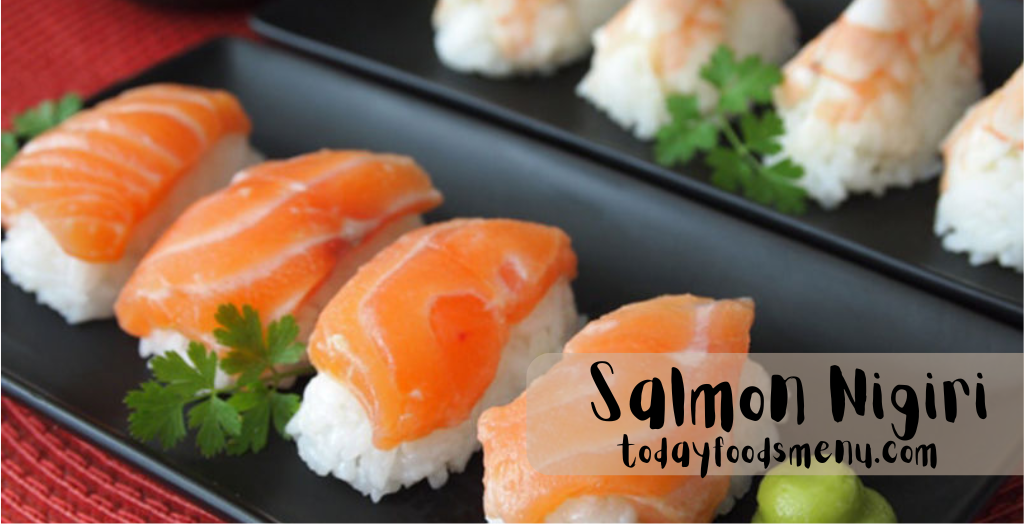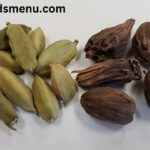Introduction
Salmon nigiri, a delicate balance of fresh fish and seasoned rice, is one of the most iconic and beloved sushi dishes worldwide. It is a simple yet elegant creation showcasing its ingredients’ purity and quality. Originating from Japan, nigiri sushi has become a global culinary sensation, with salmon nigiri standing out as a favourite due to its rich flavour and smooth texture. This article delves into the history, preparation, and cultural significance of salmon nigiri, offering insights into why this dish has captivated the palates of sushi lovers everywhere.
Origins of Sushi
In its earliest form, sushi began as a method of preserving fish. In ancient Southeast Asia, fish was salted and fermented with rice, which allowed it to be stored for extended periods. This technique, known as narezushi, was introduced to Japan around the 8th century. Over time, the Japanese adapted this method, eventually leading to the creation of sushi as we know it today.
Sushi underwent a significant transformation in the Edo period (1603-1868). Hanaya Yohei is credited with inventing nigiri sushi in the early 19th century. Unlike the fermented version, nigiri sushi consisted of fresh fish atop a small ball of vinegared rice, making it a quick and convenient meal. This new sushi style became immensely popular in Edo (now Tokyo) and spread throughout Japan, laying the foundation for modern sushi.
Introduction of Salmon in Sushi
Interestingly, salmon was not traditionally used in Japanese sushi. This is because wild salmon in Japan was often infected with parasites, making it unsafe to eat raw. In the late 20th century, salmon became a staple in sushi, thanks to the efforts of Norwegian seafood exporters.
In the 1980s, Norway launched a campaign to promote the use of its farmed salmon in Japanese sushi. Farmed salmon was parasite-free and had a milder, fattier taste, making it ideal for sushi. The campaign was successful, and by the 1990s, salmon nigiri had become a standard offering in sushi restaurants across Japan and beyond.
The Art of Preparing Salmon Nigiri
Selecting the Right Salmon
The key to exceptional salmon nigiri lies in the quality of the fish. Sushi chefs often use a specific type of salmon known as “sake” in Japanese. This can include wild-caught varieties such as king salmon (chinook) or sockeye salmon and high-quality farmed salmon from cold waters.
The salmon must be fresh, with a vibrant orange colour and a smooth, firm texture. The fatty belly portion, called “toro,” is particularly prized for its rich, buttery flavour and is often reserved for special occasions or high-end sushi restaurants.
The choice between wild and farmed salmon depends on personal preference and availability. Wild salmon, mainly those caught during peak season, offers a more intense flavour and firmer texture. However, farmed salmon is more consistent in fat content, which many sushi chefs appreciate for its buttery texture and mild taste. Sustainability also plays a role in selection, with many chefs opting for responsibly sourced salmon to ensure the long-term health of fish populations and marine ecosystems.
The Rice: A Crucial Component
While the salmon is the dish’s star, the rice plays a critical supporting role. Sushi rice, or “share,” is short-grain rice seasoned with vinegar, sugar, and salt. The rice should be slightly warm, with each grain distinct but sticky enough to hold its shape.
The balance of vinegar in the rice is crucial; it should complement the fish without overpowering its flavour. Mastering the preparation of sushi rice is considered a fundamental skill for sushi chefs, and it often takes years of practice to perfect. The texture and taste of the rice are as crucial as the quality of the fish, and a perfect nigiri should have a harmonious balance between the two.
Making sushi rice begins with carefully washing the rice to remove excess starch, then soaking and cooking. Once cooked, the rice is gently mixed with the vinegar seasoning while being fanned to achieve the right consistency and temperature. This method ensures that the rice is sticky yet light, providing a perfect base for the salmon.
Crafting the Perfect Nigiri
To create salmon nigiri, the sushi chef begins by slicing the salmon into thin, even pieces. The ideal thickness is around 1/4 inch, allowing the fish to drape gracefully over the rice. The chef then forms a small ball of sushi rice, typically weighing around 20 grams, and shapes it with gentle pressure.
Next, the chef places the slice of salmon over the rice, pressing it lightly to ensure it adheres. Some chefs add a touch of wasabi between the fish and rice for an extra kick of flavour, while others may brush the fish with soy sauce or a unique glaze. The finished nigiri should be a harmonious blend of textures and flavours, with the melt-in-your-mouth salmon contrasting with the slightly chewy, seasoned rice.
The art of nigiri lies in the subtle details: the angle of the knife when slicing the salmon, the amount of pressure applied when shaping the rice, and the precise amount of wasabi used. These small nuances can significantly impact the final taste and texture of the nigiri, making it a dish that requires both skill and intuition.
The Cultural Significance of Salmon Nigiri
A Symbol of Fusion Cuisine
Salmon nigiri is a prime example of how traditional Japanese cuisine has evolved through the influence of global ingredients. Introducing Norwegian salmon into sushi culture marked a significant shift in Japanese culinary practices, blending foreign and domestic elements to create something new.
Today, salmon nigiri is celebrated as a symbol of culinary fusion. It represents the adaptability and creativity of sushi chefs who continue to innovate while honouring the foundations of their craft. This dish has also helped popularize sushi worldwide, making it accessible to a broader audience.
The story of salmon’s integration into Japanese sushi is also a testament to the global nature of food culture. What was once a local dish rooted in specific traditions has become a canvas for international collaboration and experimentation. This cross-cultural exchange has enriched sushi, making it a versatile cuisine that can adapt to various tastes and preferences while maintaining its core identity.
Health Benefits and Popularity
Beyond its cultural significance, salmon nigiri is also prized for its health benefits. Salmon is rich in omega-3 fatty acids that are essential for heart health and brain function. It is also a good source of high-quality protein, vitamins, and minerals, making it a nutritious choice for those looking to maintain a balanced diet.
The simplicity of salmon nigiri, combined with its health benefits, has contributed to its widespread popularity. It is a dish that appeals to sushi aficionados and newcomers alike, offering a taste of the ocean in every bite. The balance of healthy fats, lean protein, and relatively low calories makes salmon nigiri a guilt-free indulgence for many health-conscious individuals.
Moreover, the antioxidants and anti-inflammatory properties found in omega-3 fatty acids have been linked to various health benefits, including improved cardiovascular health, enhanced cognitive function, and a reduced risk of chronic diseases. This makes salmon nigiri a delicious choice and a wise one for those looking to incorporate nutrient-rich foods into their diet.
Variations and Modern Interpretations
Aburi Salmon Nigiri
One popular variation of salmon nigiri is “aburi” salmon nigiri, where the fish is lightly seared with a blowtorch. This technique imparts a smoky flavour to the salmon and slightly changes its texture, creating a unique taste experience. The contrast between the charred exterior and the tender interior makes aburi salmon nigiri a favourite among sushi enthusiasts.
The aburi method adds a new dimension to the nigiri, allowing the salmon’s natural oils to caramelize and intensify in flavor. This variation is often served with a touch of yuzu or ponzu sauce, enhancing the dish’s complexity. Aburi salmon nigiri is an excellent example of how traditional techniques can be adapted to create new and exciting culinary experiences.
Salmon Nigiri with Toppings
Modern sushi chefs often experiment with different toppings and garnishes to enhance the flavour of salmon nigiri. Common additions include thin slices of lemon, a sprinkle of sea salt, or a dollop of roe (fish eggs). Some chefs may also use truffle oil, yuzu zest, or even caviar to add a luxurious touch to the dish.
These creative interpretations of salmon nigiri demonstrate the dish’s versatility and the endless possibilities for innovation within the sushi genre. Toppings like thinly sliced jalapeño or a drizzle of spicy mayo can add a surprising twist, appealing to those who enjoy bold flavours. The beauty of salmon nigiri lies in its ability to serve as a blank canvas, inviting chefs to explore and experiment with various ingredients while respecting the dish’s traditional roots.
In high-end sushi restaurants, it’s not uncommon to find salmon nigiri adorned with edible gold leaf or paired with rare and exotic condiments. These luxurious touches elevate the dish, transforming it into a gourmet experience that celebrates the art of sushi-making. However, even in its simplest form, salmon nigiri remains a testament to the skill and precision of the sushi chef, reflecting a deep respect for the ingredients and the craft.
Salmon Nigiri in Western Sushi Culture
Salmon nigiri has taken on its own identity in Western countries, often featuring in sushi rolls and fusion dishes. The popularity of salmon in the West has led to the creation of numerous sushi rolls that incorporate salmon in various forms, such as the Philadelphia roll (with cream cheese and cucumber) or the spicy salmon roll (with spicy mayo and avocado).
While these rolls differ significantly from traditional nigiri, they reflect the adaptability of sushi as a culinary concept, capable of incorporating a
Wide range of flavours and ingredients. Western sushi chefs often embrace creative freedom, blending traditional Japanese techniques with local ingredients and flavours. This has led to a diverse and dynamic sushi culture in the West, where salmon nigiri and its variations continue to thrive.
Western tastes have also led to salmon nigiri’s popularity as part of omakase menus, where chefs present a curated selection of sushi that often includes innovative takes on classic dishes. In these settings, salmon nigiri may be served alongside other fusion-inspired creations, highlighting the global evolution of sushi.
The Proper Way to Eat Nigiri
While there are no strict rules for enjoying sushi, traditional practices enhance the experience. Nigiri sushi is typically eaten with fingers, allowing you to appreciate the texture and warmth of the rice. When dipping nigiri in soy sauce, it’s recommended to dip the fish side, not the rice, to prevent the rice from absorbing too much soy sauce and falling apart.
Many sushi lovers enjoy adding a small amount of wasabi or ginger to their nigiri, but keeping the delicate flavours of the fish and rice manageable is essential. The goal is to savour the balance of ingredients, allowing each bite to reveal the subtle nuances of the dish. Eating sushi in a single bite is another common practice, ensuring that the flavours of the fish, rice, and any condiments blend perfectly in your mouth.
Sushi etiquette also suggests starting with lighter fish and working your way to richer, more flavorful pieces. This approach allows your palate to adjust, gradually enhancing your appreciation of each subsequent bite. With its balanced flavour and texture, Salmon nigiri is often enjoyed mid-meal, serving as a delightful transition between different types of sushi.
Pairing Salmon Nigiri with Drinks
Salmon nigiri pairs beautifully with a variety of beverages. In Japan, it is often enjoyed with sake, a traditional rice wine that complements the flavours of sushi. The clean, crisp taste of sake enhances the richness of the salmon, creating a harmonious dining experience.
Green tea is a popular non-alcoholic option for those who prefer it. The tea’s astringency helps cleanse the palate between bites, allowing you to fully appreciate the flavour of each piece of nigiri. Additionally, some sushi restaurants offer unique pairings with sparkling water or light, citrusy drinks that complement the fresh taste of the fish.
Salmon nigiri is also paired with wine, particularly white wines like Chardonnay or Sauvignon Blanc in Western contexts. These wines, with their crisp acidity and subtle fruit notes, balance the richness of the salmon, providing a refreshing contrast. Beer, exceptionally light lagers or Japanese beers like Asahi or Sapporo is another popular pairing, offering a clean, refreshing counterpoint to the fatty, flavorful salmon.
The Global Influence of Salmon Nigiri
The Spread of Sushi Culture
The rise of salmon nigiri is a testament to the global spread of sushi culture. From high-end sushi bars in Tokyo to casual sushi chains in New York, salmon nigiri is ubiquitous on menus worldwide. Its appeal transcends cultural boundaries, making it a favourite among diverse populations.
The international popularity of salmon nigiri has also led to the growth of sushi education and appreciation. Sushi-making classes, sushi festivals, and sushi-themed events are now standard in many countries, allowing people to engage with this culinary art form on a deeper level. These events often celebrate the artistry of sushi-making, offering participants the chance to learn about the techniques, history, and cultural significance of dishes like salmon nigiri.
Salmon nigiri remains a central figure as sushi culture continues to evolve, symbolizing the harmonious blend of tradition and innovation that defines modern sushi. The dish’s global influence is evident in how different cultures have embraced it, each adding its unique twist while respecting the core principles of sushi-making.
The Role of Sustainability
As demand for salmon continues to grow, sustainability has become a crucial consideration in the production and consumption of salmon nigiri. Overfishing and environmental concerns have prompted the sushi industry to seek more sustainable sources of salmon.
Many sushi restaurants now prioritize sourcing salmon from sustainable fisheries or aquaculture operations that adhere to strict environmental standards. Consumers are also becoming more aware of the importance of sustainability in seafood, leading to a greater emphasis on responsible choices in the sushi industry.
Organizations like the Marine Stewardship Council (MSC) and the Aquaculture Stewardship Council (ASC) significantly promote sustainable practices. They offer certification to fisheries and farms that meet their rigorous standards. By choosing MSC or ASC-certified salmon, sushi chefs and consumers can support sustainable fishing practices, ensuring that salmon nigiri remains a delicious and responsible choice for future generations.
Conclusion
Salmon nigiri is more than just a dish; it reflects the artistry, tradition, and innovation that define Japanese cuisine. From its humble beginnings in Edo-period Japan to its status as a global culinary icon, salmon nigiri has captivated the hearts and palates of people worldwide.
Whether enjoyed in a traditional sushi restaurant or crafted at home, salmon nigiri offers a taste of the sea in its purest form. Its delicate balance of flavours and textures, rich history, and cultural significance make it a true masterpiece of the culinary world. As sushi continues to evolve and adapt to new influences, salmon nigiri remains a timeless classic, beloved for its simplicity, elegance, and the profound connection between the chef, the ingredients, and the diner.


